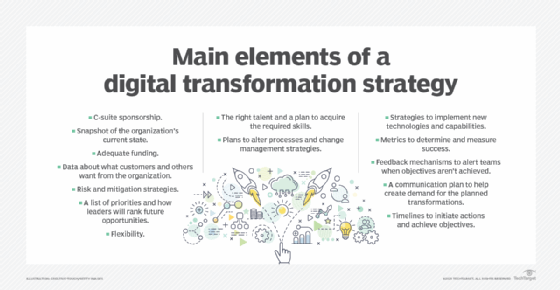
Getty Images
5 tips for better communication about digital transformation
CIOs and IT leaders must communicate effectively with stakeholders to bring about a successful digital transformation. Learn how to accomplish this, as well as potential challenges.
Many CIOs and IT leaders struggle to effectively communicate about the importance of a digital transformation.
That was one of the topics of discussion at the "Maximizing Digital Value: Transforming IT Operations for Stakeholder Success" presentation at the 2024 MIT Sloan CIO Symposium in Cambridge, Mass., on May 14. The session was led by Mikhail Papovsky, CEO at Massaro Consulting, an IT management consulting firm located in Boston.
CIOs must reconsider the way they communicate about digital transformation and bridge the gap between a CIO's mindset and the way stakeholders think about company operations, Papovsky said in a TechTarget Editorial interview prior to the presentation.
Involving all stakeholders in a digital transformation is essential, as it helps CIOs and IT leaders unite the organization toward a common goal. Challenges CIOs might encounter when communicating with stakeholders about a digital transformation include navigating differing levels of tech expertise, aligning diverse priorities and managing resistance to change.
Learn more about how CIOs should communicate with stakeholders about digital transformation.
Why use the term digital value?
The term digital value is closely related to digital transformation.
Three different types of digital value exist, according to MIT research scientists Peter Weill, Stephanie L. Woerner and Ina M. Sebastian. One of those types is value from the customer.
"Digital value starts with the customer, and the more you know about the customer, the better," Papovsky said in the interview.
The other two types of digital value are value from operations and value from ecosystems. For example, a type of digital value from operations is cutting down on costs. A digital transformation can help organizations capture more digital value.
Digital value might apply differently to different organizations, depending on various factors.
"[Digital value for each company] depends on the industry, the maturity of the organization and the capabilities of the organization," Papovsky said.
Different types of digital value might apply more to different employees' day-to-day work. For example, a software developer might think about digital value in terms of the value gained from making a change to code, while an analyst might think about digital value in terms of the value that results from implementing a new tool during a digital transformation.
Companies' access to information can dictate the type of digital value that they can capture.
"[Digital value] depends on availability of data," Papovsky said. "If you're a B2C [operation], you have that much more social media ... data available."
A B2C company can use customer information to obtain more value.
The challenges of communicating with stakeholders about digital transformation
CIOs can encounter a myriad of problems when attempting to effectively communicate with stakeholders about digital transformation.
The most crucial relationship for CIOs to nurture is their relationship with the CEO. By doing so, CIOs can align IT strategies with the company's overall business goals. But building and maintaining that connection can be challenging.
"You've got these two parties that don't communicate the same way, so those [tough] conversations end up being difficult," Papovsky said.
Because they communicate differently, CIOs might hesitate to take action because they feel like their decisions might not be supported by other leaders, he said.
"A lot of times, CIOs [might] say, 'Well, I [won't] do anything until the business tells me that we have new digital offerings,'" Papovsky said.
CIOs must make an effort to communicate effectively with their company's CEO. One strategy that can help is CIOs putting themselves in their CEO's frame of mind.
"A lot of CIOs don't think [like] CEOs do," Papovsky said. "They don't think like businesspeople."
But CIOs and CEOs might have more common ground than they think, Papovsky said during the MIT Sloan CIO Symposium presentation. CIOs' stakeholders often overlap with those of the CEO, such as internal customers, external customers and employees.

5 tips for communicating with stakeholders about digital transformation
Some best practices can help CIOs and IT leaders communicate more clearly with stakeholders about digital transformation, leading to a more successful process overall.
1. Create a relaxed environment
CIOs should build rapport by establishing a casual environment when engaging with stakeholders.
Creating a social atmosphere, potentially with food and drink, relaxes everyone, Papovsky said in the interview.
This informal atmosphere can then lead to meaningful discussions because stakeholders are in a more positive frame of mind.
2. Try 'management by walking around'
Management by walking around, or MBWA, enables CIOs and IT leaders to gather constructive criticism and helpful feedback on the fly.
Spur-of-the-moment interactions can sometimes lead to more helpful conversations than scheduled meetings, Papovsky said.
"It's walking into somebody's office and saying, 'Hey, Steve, you know what I was thinking? What if we try this?'" he said. "And then you learn."
3. Don't be afraid to reach out
Regularly initiating conversations with stakeholders can help CIOs foster a culture of cross-functional collaboration.
"It's about the volume of communication," Papovsky said.
CIOs must not shy away from starting conversations and asking questions, he said.
This approach can help make conversations about digital transformation go more smoothly.
4. Anticipate follow-up questions
CIOs often compile detailed reports with objective benchmarks and are taken aback when they present the report at a C-suite-level meeting and find that attendees don't unquestioningly accept the data.
CIOs must prepare for the fact that stakeholders might still have questions for them, despite the information they're presenting, Papovsky said. Stakeholders might not view the data as the end of the conversation.
CIOS should learn to anticipate questions about their data, which can help them prepare better for presentations about digital transformation.
5. Act the part
Many CIOs don't like being the center of attention, but communicating with stakeholders about digital transformation demands a more outgoing personality.
"Most CIOs are introverts, but IT executives need to push themselves out of that comfort zone and play an extrovert," Papovsky said.
CIOs and IT leaders exhibiting more outgoing behavior can also make them seem more approachable.
"The biggest recommendation for CIOs is just to be more human," Papovsky said.
Guilliean Pacheco is associate site editor for TechTarget Editorial's CIO, ERP, and Sustainability and ESG sites. Pacheco graduated from the University of San Francisco with an MFA in writing.






